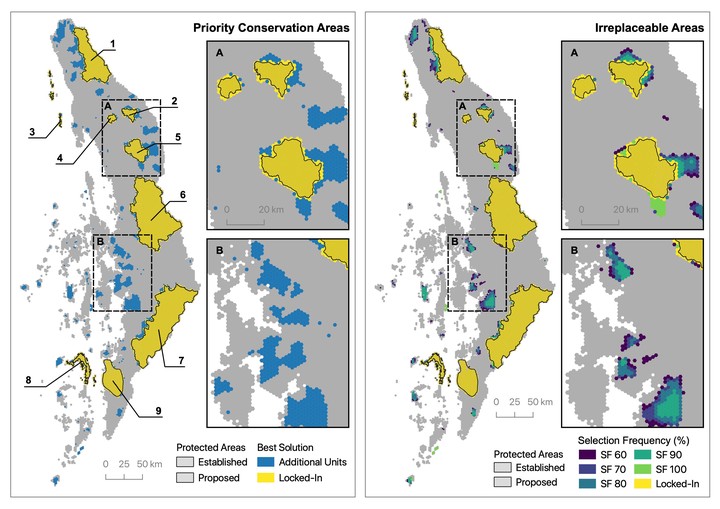Conservation beyond the existing protected area network is required to improve species and habitat representation in a global biodiversity hotspot
 Priority conservation areas (left map panel) and irreplaceable areas (right map panel), identified using Marxan to enhance the effectiveness of the existing protected area network. Note that planning units with very high selection frequencies (90–100%) are regarded as irreplaceable areas. Map inset (A) shows identified conservation areas within and around established protected areas by the Karen National Union; map inset (B) shows identified conservation areas over mangrove forests along the coastline of Myeik District, Tanintharyi Region. Protected areas include: (1) Tanintharyi Nature Reserve, (2) Ler Nu Htee National Park, (3) Moscos Kyun Wildlife Reserve, (4) Ta Mae Klo Herbal Forest, (5) Kser Doh Wildlife Sanctuary, (6) Tanintharyi National Park (or Lem Muh Lah Conservation Area), (7) Lenya National Park (or Lenya Reserved Forest), (8) Lampi Island Marine National Park, and (9) Pakchan Nature Reserve.
Priority conservation areas (left map panel) and irreplaceable areas (right map panel), identified using Marxan to enhance the effectiveness of the existing protected area network. Note that planning units with very high selection frequencies (90–100%) are regarded as irreplaceable areas. Map inset (A) shows identified conservation areas within and around established protected areas by the Karen National Union; map inset (B) shows identified conservation areas over mangrove forests along the coastline of Myeik District, Tanintharyi Region. Protected areas include: (1) Tanintharyi Nature Reserve, (2) Ler Nu Htee National Park, (3) Moscos Kyun Wildlife Reserve, (4) Ta Mae Klo Herbal Forest, (5) Kser Doh Wildlife Sanctuary, (6) Tanintharyi National Park (or Lem Muh Lah Conservation Area), (7) Lenya National Park (or Lenya Reserved Forest), (8) Lampi Island Marine National Park, and (9) Pakchan Nature Reserve.
Abstract
Adequate representation of species and habitats is a critical aspect of an effective protected area (PA) network. Here, we evaluate the representation of focal wildlife species and forest types within the existing 11,241-km2 PA network of the Tanintharyi Region in southern Myanmar, a frontier forest landscape and global biodiversity hotspot, and use spatial prioritisation tools to identify additional priority areas for conservation outside the existing network that contribute towards meeting a 30% representation target. Our study showed that the current configuration of the existing PA network underrepresented 32 of 60 threatened wildlife species and 6 of 8 forest types, with mangroves being the least represented. Spatial prioritisation revealed that by protecting an additional 4032 km2 (8.4% of Tanintharyi’s land area), 31% of which were adjacent to the existing PA network, the target representation for all wildlife species and forest types can be achieved. Enhancing the effectiveness of the existing network entails modest expansion by establishing additional conservation areas through various area-based conservation strategies, specifically targeting mangrove forests. Large oil palm agribusiness concessions, however, overlapped with almost 12% of priority conservation areas (consisting of additional areas and parts of the existing PA network), thereby competing with conservation interests. Expanding the area of representation will only succeed if the species and their habitats are adequately protected. Efforts therefore must prioritise the involvement and leadership of local communities and reflect local realities in negotiations among stakeholders.